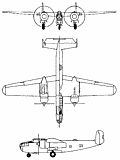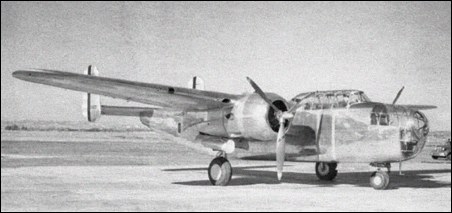|
| The NA-40 was North American's offering to
a 1938 Air Corps request for a twin engine
attack bomber. The all-metal plane had
the relatively new tricycle landing gear
and a narrow fuselage, seating the pilot
and co-pilot in tandem. Provisions were
made for a crew of five and 540kg
of bombs. A fuel capacity of 1800 litres
fed the two 1100hp Pratt &
Whitney R-1830-S6C3-G Twin Wasp engines.
Gross weight was 8850kg.
In January, 1939, the NA-40 was first
flown, but the top speed of 425km/h was
considered insufficient. A month later, as
the NA-40-2, it again took to the air, but
power was increased to 1,300hp per
engine with a pair of Wright R-2600-A71
Cyclones. The new engines boosted the
top speed to 460km/h, and the gross
weight to 9500kg.
In March, the NA-40-2 was delivered
to Wright Field for Air Corps testing.
During this program, the plane showed
outstanding performance characteristics,
and up to seven further versions of the
design were proposed. Unfortunately, the
development of the NA-40 was halted
when one of the test pilots lost control
of the aircraft during a landing approach
and, although the crew escaped, the
single NA-40 prototype was destroyed by
fire following the crash.
As an attack bomber, the NA-40 was
to carry one 7.62mm M-2 machine gun in
a rotating nose blister, one in the dorsal
turret, and another firing through the rear
floor. Two fixed 7.62mm's were planned for
installation in each wing.
The NA-40 did not receive a military
designation or serial number.
 | A three-view drawing (500 x 665) |
| MODEL | NA-40-2 |
| WEIGHTS |
| Take-off weight | 9534 kg | 21019 lb |
| Empty weight | 6338 kg | 13973 lb |
| DIMENSIONS |
| Wingspan | 20.12 m | 66 ft 0 in |
| Length | 14.71 m | 48 ft 3 in |
| Height | 4.62 m | 15 ft 2 in |
| Wing area | 55.56 m2 | 598.04 sq ft |
| PERFORMANCE |
| Ceiling | 7620 m | 25000 ft |
| Range | 1932 km | 1201 miles |
| Timothy Potter, e-mail, 21.03.2016 15:23 Gosewinus, 42-87366 was a North American NA-40 attack bomber. The NA-40 was North American's offering to a 1938 Air Corps request for a twin engine attack bomber. The all-metal plane had the relatively new tricycle landing gear and a narrow fuselage, seating the pilot and co-pilot in tandem. Provisions were made for a crew of five and 540kg of bombs. A fuel capacity of 1800 litres fed the two 1100hp Pratt & Whitney R-1830-S6C3-G Twin Wasp engines. Gross weight was 8850kg.
Hope this helps. reply | | Gosewinus, e-mail, 14.02.2016 12:44 Oorschot: Now 14-2-2016, still non comments reply | | Klaatu, e-mail, 20.08.2011 02:19 This airplane was designed to fulfill a requirement for a light attack-bomber, similar to the Martin Maryland and the Douglas DB-7 (later known as the Boston, Havoc and A-20). Although this North American prototype proved unsuccessful, it was subsequently re-designed as a medium bomber, which became the famous B-25 Mitchell. reply | | alex, e-mail, 27.09.2010 22:31 We were on Basilan Island 10 miles south of Zamboanga mainland Mindanao, Philippines.
Elements of the 41st. Div. had landed on Zamboanga the day before. We could clearly hear the naval gunfire and aerial assault happening across Basilan straight
Harry and I were on the Provincial highway heading East towards my Father's sawmill tracking the cow. because the road was paved with crushed rocks we were walking on the foot path on each side of the high way.( By the way we were both bare foot as our shoes had worn out years before) When all at once the high way exploded in an uproar of noise an rock splinters. Harry jumped to the right and I to the left while I was air borne I noticed the distinctive twin rudder of the B-25. we have just been strafed by 2 B-25s. We had been watching the B-25 and 2 PT boats obliterate the town of Isabela the last few days.
Neither of us was hurt. In 1954 My wife ,our 2 children I immigrated to the US
In 1956 I was hired by North American Aviation Downey Plant. In the course of conversations with my fellow employees the would ask me why I hired in at NAA. I said while I was airborne during the attack I swore I would get even. So first chance I got, I hired in.
After years of searching through library records and finally the internet I identified the B-25 unit that operated out fo Zamboanga`s Moret field. It was the Marine MAG-61 PBJ Bombers specifically the VMB-611 LT. COL. George A. Sarles commanding.
I communicated with a Jim Collins a member of the squadron until some time in 1994 he stopped answering my e-mail.
God Bless you Jim. reply | |
| | Gosewinus, e-mail, 10.09.2010 11:04 I Looking for information with the number 42-87366.
The plane was in operation at 18th squadron NEI-AF, but I cannot found any info.
Regards,
Guus F. reply |
|
Do you have any comments?
|
| 
COMPANY
PROFILE
All the World's Rotorcraft
|







